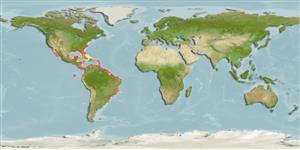Environment: milieu / climate zone / depth range / distribution range
Ecologie
marien; brak water demersaal; oceanodroom (Ref. 51243); diepte 0 - 100 m (Ref. 115829), usually 0 - 30 m (Ref. 5217). Subtropical; 11°C - 31°C (Ref. 47167); 40°N - 34°S, 117°W - 34°W
Eastern Central Pacific: Baja California to Peru (Ref. 9330); Northwestern Central Atlantic: Canada (Ref. 5951) to Chesapeake Bay, USA to the Antilles and southern Brazil.
Lengte bij maturiteit / Grootte / Gewicht / Leeftijd
Maturity: Lm 8.5, range 8 - ? cm
Max length : 22.4 cm TL mannelijk / geslacht onbekend; (Ref. 131022); common length : 15.0 cm TL mannelijk / geslacht onbekend; (Ref. 5217); max. gepubliceerd gewicht: 117.40 g (Ref. 131022); max. gerapporteerde leeftijd: 1.21 Jaren (Ref. 47359)
Dorsale stekels (totaal) : 0; Dorsale zachte stralen (totaal) : 73 - 87; Anale stekels: 0; Anale zachte stralen: 57 - 68.
Inhabits sandy and muddy bottoms (Ref. 9330). Common in estuaries (Ref. 9330). Feeds on big, benthic invertebrates and small fishes (Ref. 9330). Utilized fresh (Ref. 9330).
Levenscyclus en paargedrag
Maturiteit | Voortplanting | Paaien | Eieren | Fecunditeit | Larven
Oviparous (Ref. 101737). Distinct pairing (Ref. 205). Females produce numerous eggs in multiple spawnings during a prolonged spawning period (Ref. 101737).
Figueiredo, J.L. and N.A. Menezes, 2000. Manual de peixes marinhos do sudeste do Brasil. VI.Teleostei (5). Museu de Zoologia, Universidade de São Paulo. Brazil. 116 p. (Ref. 36453)
Status op de Rode Lijst van het IUCN (Ref. 130435: Version 2024-1)
Gevaar voor de mens
Harmless
Gebruik door de mens
Visserij: van minder commercieel belang
Tools
Speciale rapporten
Download XML
Internetbronnen
Estimates based on models
Preferred temperature (Ref.
123201): 21.1 - 28, mean 25.7 °C (based on 862 cells).
Fylogenetische diversiteitsindex (Ref.
82804): PD
50 = 0.5020 [Uniqueness, from 0.5 = low to 2.0 = high].
Bayesian length-weight: a=0.00832 (0.00660 - 0.01048), b=3.10 (3.03 - 3.17), in cm total length, based on LWR estimates for this species (Ref.
93245).
Trofisch niveau (Ref.
69278): 3.5 ±0.1 se; based on diet studies.
Generation time: 2.4 ( na - na) years. Estimated as median ln(3)/K based on 2
growth studies.
Weerstandsvermogen (Ref.
120179): Hoog, minimale populatieverdubbelingstijd minder dan 15 maanden (tmax=1.2; k >0.3).
Fishing Vulnerability (Ref.
59153): Low vulnerability (11 of 100).
Nutrients (Ref.
124155): Calcium = 191 [89, 438] mg/100g; Iron = 1.64 [0.75, 3.24] mg/100g; Protein = 17.7 [15.6, 19.8] %; Omega3 = 0.244 [0.120, 0.523] g/100g; Selenium = 36.6 [16.0, 86.1] μg/100g; VitaminA = 4.61 [1.15, 21.44] μg/100g; Zinc = 1.06 [0.66, 1.63] mg/100g (wet weight);
